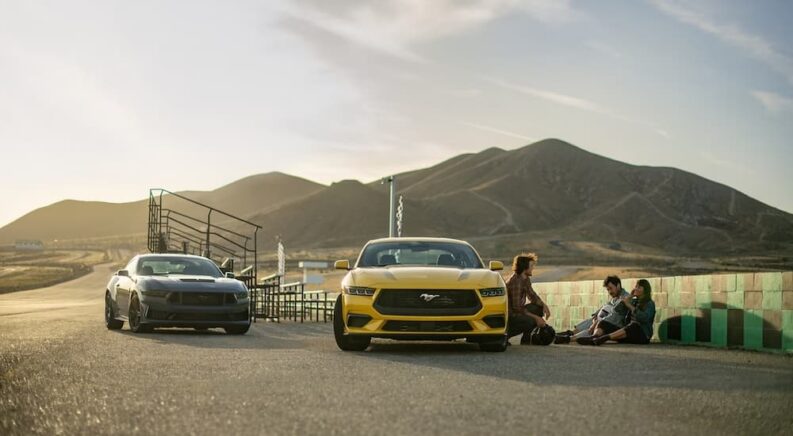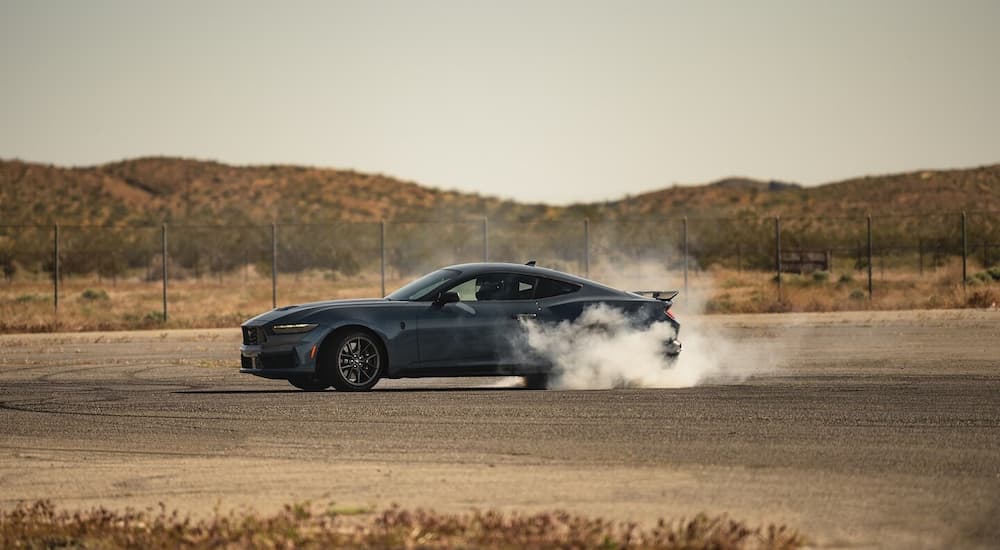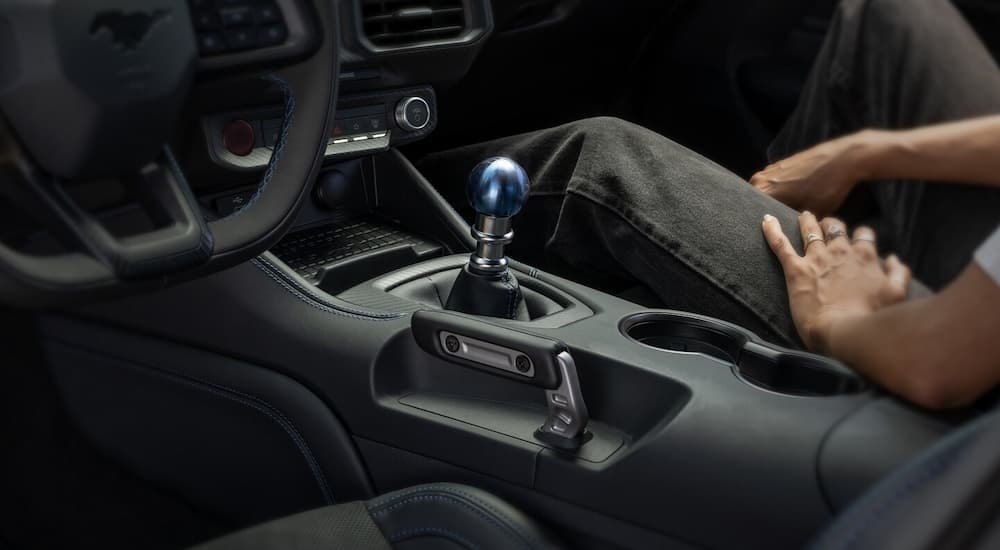From its reputation and trailblazing status to its sporty looks and guttural exhaust note, the Mustang looks every bit the sports car, but Ford hasn’t always put performance at the forefront when it comes to the original pony car. In part, this can be attributed to the Mustang’s iconic status. With so much hype and pop culture lore to its name, the model has largely been able to coast on its reputation alone. Don’t get us wrong: the Mustang provides an exciting ride and eye-catching looks to match, but pure power hasn’t always been the Mustang’s wheelhouse.
Pony cars were designed to be stylish, sporty, compact, and highly customizable, but affordability is also an important part of the equation. Take the seventh-generation (S650) Mustang’s entry-level EcoBoost trim, for instance. A quick survey of your local Ford dealer will reveal the Mustang is competitively priced at just over $30,000. Still, its 315-hp four-cylinder engine isn’t exactly going to blow away the competition at your next track day. The Mustang GT trim will fare better thanks to its 480 hp V8, but Ford hasn’t released a true high-performance version since the fifth-gen’s GT350 and GT500.
That all changes in 2024 as the S650 Mustang is introduced with not one, two, or even three, but five track-ready models. The all-new, 500 hp Mustang Dark Horse is just the tip of the iceberg when it comes to pony car performance, with Ford rounding out the lineup with a street-legal Mustang GTD supercar and three track-exclusive offerings in the Dark Horse R, GT4, and GT3. These race-ready models won’t be cheap, with the Dark Horse R retailing for almost $150,000 and the GTD priced at around $300,000, but they do go a long way in upping the Mustang’s profile amongst the performance set.
With so many new models on offer for 2024, we thought it would be the perfect time to review the Mustang’s extensive seven-model lineup. From street-legal versions like the value-packed EcoBoost and new Dark Horse to track-exclusive beasts like the GT4 and GT3, Ford has really opened the floodgates in celebration of the muscle car’s seventh generation. How do these models compare, what sort of driving are they designed for, and what surprises do they have in store? We’ll explore all that and more as we take a closer look at every 2024 Mustang.
Mustang EcoBoost
The EcoBoost might represent Mustang’s base-level trim for 2024, but it’s anything but basic. Named after the 315 hp, 2.3L EcoBoost engine found under the hood, the trim provides a fun yet efficient ride for any driver looking to get a taste of the Mustang lifestyle on a budget. Drivers will be limited to a 10-speed automatic transmission as Ford has axed the manual that was available on the sixth-gen version, but the EcoBoost is still no slouch in terms of performance with a standard limited-slip differential.
While the EcoBoost might be a little underwhelming when compared to the likes of the Dark Horse or GTD, it does provide something those versions don’t: value. Starting at just $30,920, the 2024 Mustang EcoBoost stays true to the original pony car formula by prioritizing affordability alongside performance and style. This value extends to the EcoBost’s fuel economy, where drivers will enjoy 22 MPG in the city and 33 MPG on the highway. That represents a marked improvement over the Mustang’s V8 offerings, which get as little as 14 MPG in the city and 22 MPG on the highway.
The EcoBoost is also packed with a long list of tech and safety features, including all of the Ford Co-Pilot360 advanced driver assistance systems (ADAS) like a Lane-Keeping System, Auto High-Beam Headlamps, and Pre-Collision Assist with Automatic Emergency Braking. The new Mustang also comes standard with Ford’s SYNC 4 infotainment system, which can be accessed via the muscle car’s massive 13.2-inch touchscreen.
Mustang GT
The turbocharged EcoBoost manages to squeeze a lot of power out of just four cylinders, but if you’re looking for that classic muscle car feel, nothing but a V8 will do. The GT represents the first of the Mustang’s V8-powered models with a 5.0L Coyote V8 that’s good for 480 hp and 415 lb-ft of torque (or 486 hp and 418 lb-ft of torque with the performance exhaust package). It might not be the 500 hp option found on some of the high-performance models, but it should be more than enough to inject a little excitement into highway driving as you speed from zero to 60 mph in 4.2 seconds.
If there’s any question about the Mustang GT’s performance credentials, the choice of transmission should clear up the confusion. Ford offers the GT with a six-speed manual transmission with rev-matching as well as the 10-speed automatic, sending a clear message that this Mustang was meant to be pushed to its limits. A vented hood, a flat-bottom steering wheel, and a decklid spoiler give the GT a sporty look, but the GT Premium trim adds leather seats, aluminum pedals, and side-mounted lights that project the famous Mustang logo onto the asphalt.
The available MagneRide dampers go a long way in smoothing out the ride, while a tech-heavy cabin offers all the bells and whistles—including a 4G LTE WiFi hotspot—that drivers have come to expect from a modern vehicle. Springing for the GT Premium trims adds a universal garage door opener, heated steering wheel, nine-speaker audio system, and a wireless charging pad, which help justify the model’s $47,230 starting price ($52,730 for the convertible).
Mustang Dark Horse
The Dark Horse represents Ford’s triumphant return to the world of high-performance models. It takes up where the Mustang Mach 1 left off but adds even more performance-focused features. Ford has outfitted the $59,485 Mustang with an upgraded 500 hp Coyote V8 sporting a dual throttle body intake and forged connecting rods swiped from the GT500, but that’s just the tip of the iceberg when it comes to the pony car’s performance arsenal. Weighing in at almost 4,000 lbs, the Dark Horse is a little heavier than past Mustang models, but that Coyote V8 means it can still power from zero to 60 mph in as little as 4.1 seconds. If you’re looking to enjoy the pinnacle of street-legal performance without dropping $300,000 for the GTD, the Dark Horse is worth a closer look.
Unlike the later models on the list, the Dark Horse still manages to maintain some road manners, making it a good choice for drivers who would like to enjoy all the benefits of a high-performance model without creating an uncomfortable or obnoxious driving experience. Take the Mustang’s standard active exhaust, for example. Quiet mode will allow you to pull up to the school pickup line without scaring the kids, but Normal mode provides a throaty response that should turn a few heads. Sport mode raises the din even further, while Track mode creates the recognizable racket that a Mustang deserves. This ethos extends to the interior, where drivers will find a well-appointed cabin that’s a little more luxurious than some of the relatively spartan track-exclusive offerings.
Mustang GTD
The Mustang GTD blurs the line between production cars and race cars. While Ford has made sure to keep the GTD street-legal, it could also be called into service at a local racing series or track day at a moment’s notice. Heavily based on the GT3 version of the seventh-gen Mustang, the GTD makes some compromises in the name of legality, cost, and comfort, replacing the GT3’s 5.4L Coyote V8 and dog-tooth gearbox with a supercharged 5.2L V8 and a Tremec dual-clutch automatic transmission.
Don’t be fooled by the GTD’s street-legal status. In many ways, it has more potential than some of the track-exclusive models, which, despite their motorsports components and dedicated design, still must adhere to the rules and regulations laid down by the racing series in which they were designed to compete. Ford faced no such limits in designing the GTD, allowing the automaker (along with its production partner, Multimatic) to pull out all the stops. “The technology in Mustang GTD goes beyond what’s allowed in racing,” reads Ford’s own press release.
This technology includes a supercharged 5.2L V8, which was borrowed from the Mustang Shelby GT500 and can churn out more than 800 hp, making it too powerful for the GT4 or GT3 class. The model also features a sophisticated transmission cooler, carbon fiber body, and a dry-sump oil system that represents a first in a street-legal Mustang. The Multimatic pushrod suspension uses adaptive spool valve dampers and has a Track mode that lowers the ride height by 1.6 inches.
What is the Mustang GTD for? Pure exhilaration. Priced at $300,000, the GTD is no daily driver but should provide no shortage of thrills when you decide to break it out. “This is a new approach for us,” says Jim Farley, Ford president and CEO. “We didn’t engineer a road car for the track, we created a race car for the road. Mustang GTD takes racing technology from our Mustang GT3 race car, wraps it in a carbon fiber Mustang body, and unleashes it for the street.”
Mustang Dark Horse R
Ford has introduced a second Dark Horse variant for 2024, but it is going to be pretty hard to spot in the wild unless you’re spending your weekends down at the local race track. The Dark Horse R represents the first of three Mustang models that are a little too fun to be street-legal, with the GT4 and GT3 rounding out Ford’s track-only lineup. That said, the Dark Horse R will be a good deal more accessible with a $145,000 price tag—less than half of what the GT4 and GT3 retail for. Marketed as a turnkey race car, the Dark Horse R’s relatively low price should make it a solid choice for those looking to enter the world of track racing without breaking the bank.
Those looking for an opportunity to race behind the wheel of a Dark Horse R won’t have to wait long. The Dark Horse R might be all-new for 2024, but it’s already landed its own dedicated racing series with the International Motor Sports Association (IMSA) sanctioning a Mustang Challenge spec-racing series. With the first race in June, the Mustang Challenge will be entirely composed of Dark Horse R models. The Dark Horse R might share a name and several high-end components with the standard Dark Horse, but it looks every bit the racer with a gutted interior, roll cage, single Recaro FIA racing seat, racing harness, and quick-release steering wheel. The Dark Horse R is also outfitted with a number of goodies that should ensure on-track success, like Brembo brakes, Multimatic dampers, adjustable anti-roll bars, a Borla exhaust, and upgraded cooling and oil systems.
Mustang GT3
If you’re wondering what the $300,000-plus Mustang GT3 is built for, it’s right there in the name. Designed to compete in the Federation Internationale de l’Automobile (FIA) Group GT3 race series from the IMSA WeatherTec SportsCar Championship to the FIA World Endurance Championship, the souped-up ‘stang has all the high-end equipment you’d need to compete for the checkered flag at some of the world’s most famous tracks.
First unveiled at the 2023 24 Hours of Le Mans, the Mustang GT3 will return to the French track this summer to compete in the legendary endurance race. The GT3 will be heavily inspired by the Mustang’s Dark Horse trim, allowing teams to meet GT3 regulations that require competing vehicles to be based on current production models. Powered by a Coyote-based 5.4L V8 engine and fitted with a king’s ransom in high-performance parts, the Mustang GT3 should have no problem producing the 500 to 600 hp required for the class.
Ford collaborated with performance specialists M-Sport and Multimatic to build the GT3 and has teamed up with Multimatic Motorsports to race two GT3 cars in the IMSA GTD Pro class this season. The Mustang GT3 took to the track for the first time for the 2024 Daytona 24 Hours in January, where the cars finished a respectable sixth and ninth. The car will also be raced by various customer teams, with Germany-based Proton Competition becoming the first to announce its 2024 campaign in the World Endurance Championship.
Mustang GT4
The Mustang GT3 will be joined by a GT4 model, which will compete in a number of international racing series, including the IMSA Michelin Pilot Challenge and the IMSA VP Racing Sports Car Challenge. While many GT3 racing teams are operated by or receive support from established automakers, GT4 tends to be a little different. Most GT4 teams are made up of young, amateur drivers looking to cut their teeth in the world of auto racing. Many GT4 racing series actually bar professionals from entering, creating the perfect training ground to help younger drivers learn the sport.
As such, GT4 cars tend to be a little less powerful and well-equipped than their GT3 cousins. They don’t have as much horsepower or produce as much downforce as GT3 models, though they must also be based on existing production models. GT4 cars are tested by the FIA or the specific series’ governing body and can usually not be modified after passing the approval process, which limits the sort of ongoing development costs that can make auto racing such an expensive hobby.
Like the GT3, the Mustang GT4 was designed and produced with the help of Multimatic and features a host of high-performance equipment, including Multimatic DSSV dampers, a premium aero package, and paddle shifters that feature pneumatic actuation. The GT4 also comes with a Holinger dog-ring gearbox, which offers some significant advantages over the standard design. Specifically, the dog-ring gearbox enables much faster gear changes, allowing a driver to shift between gears without using the clutch. The less time spent freewheeling with the clutch, the less interruption to power, giving drivers a key advantage out on the track.
Here Come the Galloping Mustangs…
Those seeking a high-performance Mustang are rewarded with a full suite of options as Ford kicks off the model’s seventh generation. While some of these high-octane variants might be outside the price range of the average driver, they’re sure to find an audience amongst the speed demons who populate track days and racing series like GT3 and GT4. No matter which Mustang model you choose, you’ll enjoy a unique ride that’s kept the original pony car at the segment’s forefront since it was first unveiled almost 60 years ago.
Ford has been taking all sorts of bold chances with the Mustang in recent years, and its experiments haven’t been limited to high-performance models like the Dark Horse R, GTD, GT4, and GT3. The automaker has also experimented with an all-electric Mustang-inspired model in the Mustang Mach-E, which, while technically an SUV, speaks to the potential for a potential EV version of the pony car. While we’re eager to see what else Ford has in store as it kicks off this new era of Mustang models, it sure seems to be off to a good start with the newly expanded lineup.







